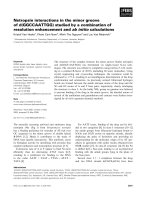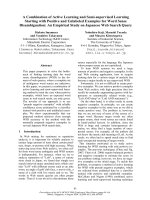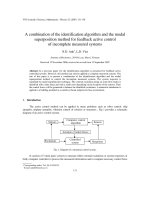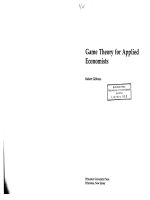A Combination of Evolutionary Algorithm and Game Theory for Optimal Location and Operation of DG from DG Owner Standpoints
Bạn đang xem bản rút gọn của tài liệu. Xem và tải ngay bản đầy đủ của tài liệu tại đây (103.79 KB, 3 trang )
Maximizing DG Hosting Capacity
Abstract
As the amount of distributed generation (DG) is growing worldwide, the need to increase the hosting capacity of distribution systems is becoming a major concern. In this paper, the main
achievements stacked over the last 15 years to realize this goal have been summarized into 5 stages which are able to be arranged with time order. First of all, voltage rise problem is deeply
studied when connecting DGs in existing networks. Secondly, as a effective tool for evaluating the quantified amount of DG connection capability, optimal power flow (OPF) technique is
presented. Thirdly, centralized and distributed voltage control methods are compared to show the benefits in terms of improving DG penetration. For 4th stage, multi-period AC optimal power
flow technique is introduced to measure the impact of active network management (ANM) on connectable renewable capacity. As final stage up to the present, the means of network
reconfiguration shows how the DG hosting capacity can be increased.
Index Terms
Distributed generation, voltage rise, hosting capacity, voltage control, active network management, network configuration
Contents [show]
Introduction
Edit
Many developed countries in the world, specially in Europe, have set the specific target to replace massive, centrally-dispatched power generation with distributed renewable energy resources
(DERs) such as solar PV, wind turbine and so on. This trend naturally has lead utility companies to develop their own measures to "host" more DGs in distribution networks in a economic way
with the assurance of reliable operation of existing facilities.
The current practice to connect DGs in existing network is based on the principle of "fit-and-forget", i.e., allowing accommodation of DG only if it does not lead to constraint violation even under
the worst-case scenario. Under this passive network scheme, DG is without control in the operation, the task of balancing supply and demand as well as the task of securing frequency and
voltage has been left solely to large production units. Therefore, the positive role of DG on improving branch power flow and node voltage is weakened. In some cases, the penetration of DG
must be controlled strictly, and the benefit and extension of DG have been confined.
These "firm" connections mandate that DG is able to output full capacity irrespective of network configuration normally such as maximum generation at minimum demand. While reasonable for
firm energy sources, with variable renewables, maximum generation may occur for a relatively small amount of time. Firm connection would require that the DG capacity be restricted despite the
opportunity for much higher energy production. The alternative is a "non-firm" connection wherein distribution network operator(DNO) may curtail the output of the renewable generator at low
demand.
In the same context of introducing non-firm connection in the grid, the emerging ANM schemes have proved to be beneficial for DNOs compared to passive network management. ANM
schemes have been proposed as a solution to significantly increase the amount of DG capacity, while exploiting DG benefits. Within this new paradigm, ANM schemes can enhance and
maximize the utilization of network's assets under the current infrastructure and hence, defer or avoid costly network upgrades. The major ANM schemes include 1) coordinated voltage
control(CVC) on-load tap changers(OLTCs) and voltage regulators, 2) compensator reactive power control or DG's power factor control (PFC) and 3) energy curtailment (EC). In general, it is
found that as the DG penetration increases the investment cost to implement ANM schemes in existing distribution system becomes more viable and justifiable.
In this paper, the technical advancements dealing with DG penetration expansion and development of ANM schemes over 15 years since the beginning of 21st century have been explicitly
organized based on the selected 10 papers into the following 5 stages with time order :
1. Voltage rise issue
2. Optimal power flow(OPF) evaluation
3. Voltage control : Centralized and decentralized
4. Multi-period AC OPF under ANM strategies
5. Network configuration : Static and dynamic
These topics related to each stage and their papers are explained in the following 5 sections, respectively.
Voltage rise issue (2001~2004)
Edit
In this section, three papers discuss the maximization of DG hosting capacity within the satisfactory level of system constraints mainly focusing on voltage rise issue caused by the connection of
new DGs.
“Voltage rise: The big issue when connecting embedded generation to long 11 kV overhead lines” by C. L. Masters [1] summarizes the results of some generic studies, explaining voltage rise
issue and how it may be overcome. In detail, it compares the voltage profiles along the 11kV overhead line from the primary substation with and without the connection of DG. And, it suggests
several techniques that can be employed to alleviate the voltage rise such as reducing the primary substation voltage, allowing the embedded generator to import reactive power, installation of
auto transformer or voltage regulator, increase of conductor size, constraint of the generator at low demand times and a combination of the stated before. The effect of using various methods to
reduce the voltage rise has been shown up in graph with some case studies.
“Maximising penetration of wind generation in existing distribution networks” by S. N. Liew et al. [2], presents the counter-measures to overcome the capacity limitation when connecting
embedded wind generation (EWG) in the rural distribution system which is susceptible to voltage rise. The benefits of alternative active network controls are demonstrated such as generation
curtailment, reactive power absorption and co-ordinated OLTC control for voltage regulation within an existing distribution network. It was shown that, by implementing active network
management, the increase in installed capacity of EWG which can be connected to the existing distribution networks can be considerably up to a factor of 10 especially when using co-ordinated
OLTC control.
“Maximising energy capture from distributed generators in weak networks” by A. E. Kiprakis et al. [3], proposes two candidate solution from the need of intelligent control strategy for DG in order
to increase generation capacity in the distribution network : a hybrid voltage / power factor controller that uses a set of rules to switch intelligently between voltage and power factor control
modes and a fuzzy logic power factor controller that adjusts the reference setting of the automatic power factor controller in response to the terminal voltage. Both algorithms allow extension of
generator operating period in a weak network and , therefore, an increase of the revenue from energy export. This is illustrated by computer simulations of a DG in a rural network using a
realistic local load pattern.
OPF evaluation of DG hosting capacity (2005~2006)
Edit
This section includes 3 papers regarding the evaluation of the available connection capacity on the system based on OPF method developed extensively through power systems research. The
quantification of the capacity of newly installed-able DGs that may be connected to distribution networks with and without the need for grid enhancement is important because it can be the
starting point for DNOs to give initiatives to potential DG developers.
"Optimal power flow evaluation of distribution network capacity for the connection of distributed generation" by G. P. Harrison et al. [4], presents a technique that facilitates to evaluate the
allowable capacity, termed as 'reverse load-ability'. This approach models fixed-power factor distributed generation as negative loads and uses the optimal power flow to perform negative load
shedding that effectively maximizes capacity and identifies available headroom. This technique can be applied to an extensive distribution and sub-transmission network and rapidly identify
available headroom within the imposed thermal and voltage constraints.
“Optimal power flow as a tool for fault level-constrained network capacity analysis" by P. N. Vovos et al. [5], presents a new method for the allocation of new generation capacity, which takes into
account network constraints and restrictions imposed by protection equipment such as switchgear fault ratings. The algorithm using fault level constrained optimal power flow(FLOPF) allows
locational preferences to be expressed for the connection of new capacity. It was proven that there is a trade-off between higher allocation of capacity at the preferred capacity expansion
locations and total new capacity. It results in significantly high allocation in a capacity planning mechanism that exploits the potential connection capacity better than the current first-come-firstserved policy.
“Direct incorporation of fault level constraints in optimal power flow as a tool for network capacity analysis” by P. N. Vovos et al. [6], presents a method for the direct incorporation of fault level
constraints(FLCs) in the optimal power flow as a tool for network capacity analysis. A mathematical methodology to convert constraints imposed by fault levels to simple nonlinear inequality
constraints is developed. Therefore, once FLCs are converted to nonlinear constraints described by OPF variables, the can be directly introduced to any optimization process performing the
OPF. A test case demonstrates the advantages of the new method in comparison with a previoulsy proposed iterative method that converted them to restrictions on new capacity.
Voltage control : Centralized and Distributed (2007~2009)
Edit
In this section, one paper from the issue of voltage regulation in the distribution network is presented including the comparison between control methods and the introduction of their
characteristics.
"Centralized and distributed voltage control: Impact on distributed generation penetration" by P. N. Vovos et al. [7], aims to compare the centralized and distributed approaches for controlling
distribution network voltages in terms of the capacity of DG that could be accommodated within existing networks as well as contrasting them with the current power factor control approach. By
using OPF techniques with the incorporation of the intelligent generator control algorithm, this paper shows that intelligent distributed voltage and reactive power control of the DG gives similar
results to those obtained by centralized management in terms of the potential for connecting increased capacities within existing networks.
Multi-period AC OPF under ANM strategies (2010~2014)
Edit
A more sophisticated approach is required for overcoming the absence of methodologies that perform capacity assessment of variable renewable generation based on industry-accepted
optimization techniques such as OPF. In this section, two papers are devoted to the use of multi-period AC OPF techniques with ANM schemes.
“Distribution network capacity assessment : Variable DG and active networks” by L. F. Ochoa et al.[8], proposes a multi-period AC optimal power flow technique for evaluating maximum network
capacity for accommodating variable DG. It offers a means of measuring the impact of ANM on connectable renewable capacity, and consequently increasing the harvesting of energy. It was
clearly shown that, compared to the widely used passive operation of distribution networks, very high penetration levels of new variable generation capacity can be reached by strategically
adopting ANM schemes which include coordinated voltage control, adaptive power factor control and energy curtailment.
"Planning Active Distribution Networks Considering Multi-DG Configurations" by S. S. Al Kaabi et al. [9], proposes a new approach to plan the sizing of DG unit with the consideration of the
multi-DG configurations. A multi-configuration multi-period OPF technique (MMOPF) allows a better planning to determine the DG capacities at different locations. This technique takes into
consideration the impacts of multiple DG interactions by evaluating various uncertainties associated with DG number, locations, size, types and availability. The proposed technique can be an
effective tool for the sizing of DG units at multiple DG locations during the initial planning stage.
Network Configuration : Static and Dynamic (2015~2016)
Edit
In order to maximize DG hosting capacity in distribution network without reinforcements, various ANM schemes has been studied. This section includes one paper dealing with the issue in
regard to how the DG hosting capacity of active distribution systems can be increased by means of network reconfiguration, both static, i.e., grid reconfiguration at planning stage, and dynamic,
i.e., grid reconfiguration using remotely controlled switches as an way of ANM schemes.
"Assessing the Potential of Network Reconfiguration to Improve Distributed Generation Hosting Capacity in Active Distribution Systems" by F. Capitanescu et. al [10], describes the work built
upon the nonlinear programming(NLP) multi-period(MP) OPF framework proposed in Section 4 by which centralized ANM schemes are considered to cope with voltage rise and thermal
overload issues. The main contribution of this work is that it further investigated the extent of the potential benefits from adopting static and dynamic network configuration as options to increase
the ability of distribution systems to host DG by means of a mixed integer NLP(MINLP) MP-OPF formulation. It also proposes an algorithm for reducing the size of the MP-OPF for a large
number of periods.
Conclusion
Edit
In this paper, the whole picture of the continuous efforts over a decade to maximize the network capacity for hosting DGs in existing distribution system has been clearly described with the
detailed explanation of the selected 10 papers in the range of 5 topics regarding voltage rise issue, OPF evaluation, voltage control, multi-period OPF and network configuration. Consequently,
ANM schemes have been advanced in the process of the integration with these newly developed techniques and their ability to "free up" the network hosting capacity will justify the
corresponding investment required for the physical implementation based on the cost-effectiveness analysis of each scheme.
References
Edit
1. C. L. Masters, “Voltage rise: The big issue when connecting embedded generation to long 11 kV overhead lines,” Power Eng. J., vol. 16, no.1, pp. 5–12, Feb. 2002.
2. S. N. Liew and G. Strbac, “Maximising penetration of wind generation in existing distribution networks,” Proc. Inst. Elect. Eng., Gen., Transm., Distrib., vol. 149, no. 3, pp. 256–262, May
2002.
3. A. E. Kiprakis and A. R. Wallace, “Maximising energy capture from distributed generators in weak networks,” Proc. Inst. Elect. Eng., Gen., Transm., Distrib., vol. 151, no. 5, pp. 611–618,
Sep. 2004..
4. G. P. Harrison and A. R.Wallace, “OPF evaluation of distribution network capacity for the connection of distributed generation,” Proc. Inst. Elect. Eng., Gen., Transm., Distrib., vol. 152, no.
1, pp. 115–122, Jan. 2005.
5. P. N. Vovos, G. P. Harrison, A. R.Wallace, and J. W. Bialek, “Optimal power flow as a tool for fault level constrained network capacity analysis,” IEEE Trans. Power Syst., vol. 20, no. 2, pp.
734–741, May 2005.
6. P. N. Vovos and J. W. Bialek, “Direct incorporation of fault level constraints in optimal power flow as a tool for network capacity analysis,” IEEE Trans. Power Syst., vol. 20, no. 4, pp. 2125–
2134, Nov. 2005.
7. P. N. Vovos, A. E. Kiprakis, A. R. Wallace, and G. P. Harrison, “Centralized and distributed voltage control: Impact on distributed generation penetration,” IEEE Trans. Power Syst., vol. 22,
no. 1, pp. 476–483, Feb. 2007.
8. L. F. Ochoa, C. Dent, and G. P. Harrison, “Distribution network capacity assessment: Variable DG and active networks,” IEEE Trans. Power Syst., vol. 25, no. 1, pp. 87–95, Feb. 2010.
9. Al Kaabi, S.S.; Zeineldin, H.H.; Khadkikar, V. "Planning Active Distribution Networks Considering Multi-DG Configurations", Power Systems, IEEE Transactions on, On page(s): 785 - 793
Volume: 29, Issue: 2, March 2014
10. F. Capitanescu, L. F. Ochoa, H. Margossian, and N. D. Hatziargyriou, "Assessing the Potential of Network Reconfiguration to Improve Distributed Generation Hosting Capacity in Active
Distribution Systems," IEEE Trans. on Power Syst., Jan. 2015, vol. 30, pp. 346-356.
Retrieved from " />Categories:
Add category
Community content is available under CC-BY-SA unless otherwise noted.









